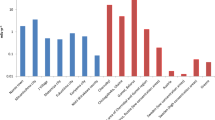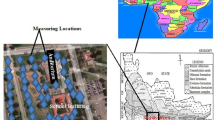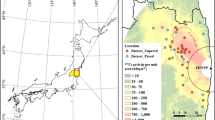Abstract
The Chernobyl Nuclear Power Plant (CNPP) accident represents one of the most significant civilian releases of 137Cesium (137Cs, radiocesium) in human history. In the Chernobyl-affected region, radiocesium is considered to be the greatest on-going environmental hazard to human health by radiobiologists and public health scientists. The goal of this study was to characterize dosimetric patterns and predictive factors for whole-body count (WBC)-derived radiocesium internal dose estimations in a CNPP-affected children's cohort, and cross-validate these estimations with a soil-based ecological dose estimation model. WBC data were used to estimate the internal effective dose using the International Commission on Radiological Protection (ICRP) 67 dose conversion coefficient for 137Cs and MONDAL Version 3.01 software. Geometric mean dose estimates from each model were compared utilizing paired t-tests and intra-class correlation coefficients. Additionally, we developed predictive models for WBC-derived dose estimation in order to determine the appropriateness of EMARC to estimate dose for this population. The two WBC-derived dose predictive models identified 137Cs soil concentration (P<0.0001) as the strongest predictor of annual internal effective dose from radiocesium validating the use of the soil-based EMARC model. The geometric mean internal effective dose estimate of the EMARC model (0.183 mSv/y) was the highest followed by the ICRP 67 dose estimates (0.165 mSv/y) and the MONDAL model estimates (0.149 mSv/y). All three models yielded significantly different geometric mean dose (P<0.05) estimates for this cohort when stratified by sex, age at time of exam and season of exam, except for the mean MONDAL and EMARC estimates for 15- and 16-year olds and mean ICRP and MONDAL estimates for children examined in Winter. Further prospective and retrospective radio-epidemiological studies utilizing refined WBC measurements and ecological model dose estimations, in conjunction with findings from animal toxicological studies, should help elucidate possible deterministic radiogenic health effects associated with chronic low-dose internal exposure to 137Cs.
This is a preview of subscription content, access via your institution
Access options
Subscribe to this journal
Receive 6 print issues and online access
$259.00 per year
only $43.17 per issue
Buy this article
- Purchase on Springer Link
- Instant access to full article PDF
Prices may be subject to local taxes which are calculated during checkout

Similar content being viewed by others
References
Friese J, Kephart R, Lucas D . Comparison of radionuclide ratios in atmospheric nuclear explosions and nuclear releases from Chernobyl and Fukushima seen in gamma ray spectrometry. J Radioanal Nucl Chem 2013; 296: 899–903.
Stone R . New effort aims to thwart dirty bombers. Science 2002; 296: 2117–2119.
International Atomic Energy Association Environmental consequences of the Chernobyl accident and their remediation. IAEA: Viena. 2006.
Svendsen E, Kolpakov I, Stepanova Y, Vdovenko V, Naboka M, Mousseau T et al. 137Cesium exposure and spirometry measures in Ukrainian children affected by the Chernobyl nuclear incident. Environ Health Perspect 2010; 118: 720–725.
Bouville A, Likhtarev I, Kovgan L, Minenko V, Shinkarev S, Drozdovitch V . Radiation dosimetry for highly contaminated Belarusian, Russian and Ukrainian populations, and for less contaminated populations in Europe. Health Phys 2007; 93: 487–501.
Hayashida N, Sekitani Y, Kozlovsky A, Rafalsky R, Gutevich A, Daniliuk V et al. Screening for 137Cs body burden due to the Chernobyl accident in Korosten City, Zhitomir, Ukraine: 1996-2008. J Radiat Res 2011; 52: 629–633.
Lindgren A, Stepanova E, Vdovenko V, McMahon D, Litvinetz O, Leonovich E et al. Individual whole-body concentration of 137Cesium is associated with decreased blood counts in children in the Chernobyl-contaminated areas, Ukraine, 2008-2010. J Expo Sci and Environ Epidemiol 2013, (doi:10.1038/jes.2013.60; e-pub ahead of print 25 September 2013).
United Nations Scientific Committee on the Effects of Atomic Radiation Sources and Effects of Ionizing Radiation: Annex J: Exposures and Effects of the Chernobyl Accident. UNSCEAR: New York. 2000.
Bernhardsson C, Zvonova I, Rääf C, Mattsson S . Measurements of long-term external and internal radiation exposure of inhabitants of some villages of the Bryansk region of Russia after the Chernobyl accident. Sci Total Environ 2011; 409: 4811–4817.
Likhtarev I, Kovgan L, Vavilov S, Perevoznikov O, Litvinets L, Anspaugh L et al. Internal exposure from the ingestion of foods contaminated by 137Cs after the Chernobyl accident-Report 2. Ingestion doses of the rural population of Ukraine up to 12 y after the accident (1986-1997). Health Phys 2000; 79: 341–357.
Pröhl G, Ehlken S, Fiedler I, Kirchner G, Klemt E, Zibold G . Ecological half-lives of 90Sr and 137Cs in terrestrial and aquatic ecosystems. J Environ Radio Activity 2006; 91: 41–72.
Hoshi M, Konstantinov Y, Evdeeva T, Kovalev A, Aksenov A, Koulikova N et al. Radiocesium in children residing in the western districts of the Bryansk Oblast from 1991-1996. Health Phys 2000; 79: 182–186.
Quastel M, Kramer G, Goldsmith J, Polyak S, Kordysh E, Noel L et al. Radiocesium body burdens in immigrants to Israel from areas of the Ukraine, Belarus and Russia near Chernobyl. Health Phys 1995; 69: 102–110.
Kravets A, Pavlenko Y . Reconstruction and forecast of doses due to ingestion of 137Cs and 90 Sr after the Chernobyl accident. Radiat Environ Biophys 2008; 47: 213–223.
International Commission on Radiological Protection Age-depended doses to members of the public from intake of radionuclides: part 2, Ingestion dose coefficients (ICRP publication 67), Ann. ICRP. 1993; 23.
SCRM AMS of Ukraine Recommendations on assessment of internal dose of irradiation from radiocesium using whole body counters. Kiev, Ukraine. 1994, pp 24 [in Russian].
SCRM AMS of Ukraine Recommendations on measurement with whole body counters during the dosimetric pasportization of residential areas of Ukraine. Kiev. 1996, pp 73 [in Russian].
International Commission on Radiological Protection Dose coefficients for intake of radionuclides by workers (ICRP Publication 68), Ann. ICRP. 1994; 24.
International Commission on Radiological Protection Limits for intakes of radionuclides by workers: part 1 (ICRP publication 30), Ann. ICRP. 1979; 2.
International Commission on Radiological Protection Age-dependent doses to the members of the public from intake of radionuclides: part 5, Compilation of ingestion and inhalation coefficients (ICRP Publication 72), Ann. ICRP. 1995; 26.
Ministry of Health of the Ukraine Certification doses for the settlements of Ukraine located in contaminated territories after the Chernobyl accident Data for 2008. Report no. 13 Kyiv. 2009 [in Ukrainian].
Krupskyi MK . The Soil Map of the Ukrainian SSR Scientific Research Institute of Pedology. Kiev. 1967. [Electronic version provided by State Land Cadastre of Ukraine, 2012. http://www.map.land.gov.ua/kadastrova-karta].
Sharifov VF, Koulikova NV, Voropal LV, Kroupnik TA, Mayakin VB, Cot VA et al. Finding of the Chernobyl Sasakawa Health and Medical Cooperation Project: 137Cs concentrations among children around Chernobyl. In: Yamashita S, Shibata Y (eds). Chernobyl: A Decade of Proceedings of the Fifth Chernobyl Medical Cooperation Symposium, Kiev, Ukraine, 14-15 October 1996. Elsevier: Amsterdam, Lausanne, New York. 1997, 39–44.
International Commission on Radiological Protection 1990 recommendations of the International Commission on Radiological Protection (ICRP publication 60), Ann. ICRP. 1991; 21.
Handl J, Beltz D, Botsch W, Harb S, Jakob D, Michel R et al. Evaluation of radioactive exposure from 137Cs in contaminated areas of Northern Ukraine. Health Phys 2003; 84: 502–517.
Balonov M, Bruk G, Zvonova I, Pitkevich V, Bratilova A, Jesko T et al. Methodology of internal dose reconstruction for a Russian population after the Chernobyl accident. Radiat Prot Dosim 2000; 92: 247–253.
Travnikova L, Bruk G, Shutov N, Bazjukin A, Balonov M, Rahola T et al. Contribution of different foodstuffs to the internal exposure of rural inhabitants in Russia after the Chernobyl accident. Radiat Prot Dosim 2001; 93: 331–339.
Sekitani Y, Hayashida N, Karevskaya I, Vasilitsova O, Kozlovsky A, Omiya M et al. Evaluation of 137Cs body burden in inhabitants of Bryansk Oblast, Russian Federation, where a high incidence of thyroid cancer was observed after the accident at the Chernobyl nuclear power plant. Radiat Prot Dosim 2010; 141: 36–42.
Kaduka M, Shutov V, Bruk G, Balonov M, Brown J, Strand P . Soil-dependent uptake of 137Cs by mushrooms: experimental study in the Chernobyl accident areas. J Environ Radioactiv 2006; 89: 199–211.
Morita N, Takamura N, Ashizawa K, Shimasaki T, Yamashita S, Okumura Y . Measurement of the whole-body 137Cs in residents around the Chernobyl nuclear power plant. Radiat Prot Dosim 2005; 113: 326–329.
United Nations Scientific Committee on the Effects of Atomic Radiation Sources and Effects of Ionizing Radiation: UNSCEAR 2008 Report to the General Assembly with Scientific Annexes: Volume II Scientific Annexes C, D, and E. UNSCEAR: New York. 2011.
National Council on Radiological Protection and Measurements Risk estimates for radiation protection (NCRP Report 115). NCRP: Bethesda, MD. 1993.
Burak II, Berdashkevich VA, Nikopchuk AP, Petracheva NV . Effect of radioactive and chemical pollution on children’s health: Effect of radionuclide contamination of the environment on human health (clinical and experimental research). Sat Scientific 1993, 16–19 [In Russian].
Gutkovskiy IA, Kulkova LV, Bletko TV, Nexai EV . Children’s health and levels of residential contamination with 137 Cs. Proceedings of the International Scientific Conference in commemoration of the 5th anniversary of the establishment of Gomel State Medical Institute. Gomel State Medical Institute: Gomel. 1995, 12–13.
Kulkova LV, Ispenkov EA, Gutkovskiy IA, Warriors IN, Ulanovskaya EV, Skidaneko GI et al. Epidimeiological Monitoring the health of children living in contaminated areas of Gomel region. Nuclear Medicine and Radiation Safety 1996; 2: 12–15.
Porada NE, Voronestzky BK, Gutkovskiy IA, Bletko TV, Boyko LV. . Comparative analysis of child morbidity Luninetsk district, living in areas with different densities of radionuclide contamination of Cesium: Medical and biological effects and ways of overcoming the consequences of the Chernobyl accident. Sat Scientific 1997, 15–16. [In Russian].
McMahon D, Vdovenko V, Karmaus W, Kondrashova V, Svendsen E, Litvinetz O et al. Effects of long-term low-level radiation exposure after the Chernobyl catastrophe on immunoglobulins in children residing in contaminated areas: prospective and cross-sectional studies. Environ Health 2014; 13: 36.
Stepanova E, Karmaus W, Naboka M, Vdovenko V, Mousseau T, Shestopalov V et al. Exposure from the Chernobyl accident had adverse effects on erythrocytes, leukocytes, and, platelets in children in the Narodichesky region, Ukraine: A 6-year follow-up study. Environ Health 2008; 7: 1–13.
Yablokov A, Nesterenko VB, Nesterenko AV . Chernobyl: consequences of the catastrophe for people and the environment. Ann N Y Acad Sci 2009; 1811: 32–41.
Grison S, Martin J, Grandcolas L, Banzet N, Blanchardon E, Tourlonias E et al. The metabolomic approach identifies a biological signature of low-dose chronic exposure to Cesium 137. J Radiat Res 2012; 53: 33–43.
Grignard E, Gu'eguen Y, Grison S, Lobaccaro J, Gourmelon P, Souidi M . In vivo effects of chronic contamination with 137 Cesium on testicular and adrenal steroidogenesis. Arch Toxicol 2008; 82: 583–589.
Martinerie L, Munier M, Le Menuet D, Meduri G, Viengchareun S, Lomb`es M . The mineralocorticoid signaling pathway throughout development: Expression, regulation and pathophysiological implications. Biochimie 2013; 95: 148–157.
Acknowledgements
Financial support for health assessments of the study population were provided by the National Academy of Medical Sciences of Ukraine, Kiev, Ukraine. Additional funding was provided by the United States Civilian Research and Development Foundation (UKB1-2929-KV-08 and UKB2-7110-KV-13). Ichiro Yamaguchi of Japan’s National Institute of Public Health and National Institute of Radiological Sciences provided the MONDAL model software and helpful comments on dosimetry for this research.
Author information
Authors and Affiliations
Corresponding author
Ethics declarations
Competing interests
The authors declare no conflict of interest.
Rights and permissions
About this article
Cite this article
Jelin, B., Sun, W., Kravets, A. et al. Quantifying annual internal effective 137Cesium dose utilizing direct body-burden measurement and ecological dose modeling. J Expo Sci Environ Epidemiol 26, 546–553 (2016). https://doi.org/10.1038/jes.2015.6
Received:
Revised:
Accepted:
Published:
Issue Date:
DOI: https://doi.org/10.1038/jes.2015.6
Keywords
This article is cited by
-
Manganese-mediated acceleration of age-related hearing loss in mice
Scientific Reports (2016)



